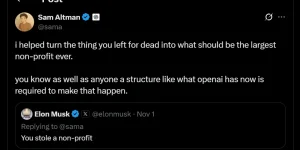It began again with a sharp exchange online. After Sam Altman shared progress on OpenAI’s latest model, Elon Musk posted a pointed response accusing the company of abandoning its founding principles. Altman replied days later with a measured but unmistakably firm note, reminding observers that OpenAI’s mission had not changed, only the scale of the challenge had. In a few messages, their long-simmering rift resurfaced in plain view.

The public flare-up brought renewed attention to a relationship that helped shape modern artificial intelligence and now symbolises its philosophical divide.
When Allies Shared a Mission
In 2015, Altman and Musk co-founded OpenAI with a promise: keep advanced AI development transparent, safe, and not in the hands of a few powerful corporations. It was a bold proposition. Altman brought strategic clarity and operational structure. Musk offered high-profile backing and early funding.
Their early alignment felt inevitable. Both saw AI as humanity’s most transformative technology. Both believed it demanded ethical stewardship. And both feared what could happen if the wrong actors gained control first.
OpenAI’s founding had the energy of a movement, not a startup. But consensus is easier when ambition is abstract.
The First Fractures Appear
As OpenAI expanded its research and ambitions, its founders confronted a reality: cutting-edge AI required enormous capital and infrastructure. Musk argued for sharper focus and faster execution. Altman believed the mission demanded broader governance and structured collaboration.
By 2018, Musk stepped away. Officially, it was about conflicts with Tesla’s AI ambitions. Unofficially, the split reflected a difference in vision and leadership style. Musk saw OpenAI straying from its idealistic beginnings. Altman saw evolution, not departure.
Shortly after, OpenAI adopted a capped-profit model to attract funding. Musk’s critique sharpened. Altman, meanwhile, continued building.
Competing Futures in an AI Arms Race
Today, Musk leads xAI, casting it as a more principled defender of free inquiry and AI safety. He argues that powerful systems must remain open and challenge narratives. Altman, now synonymous with OpenAI’s rise, champions a deployment-first approach: release models, learn in the real world, iterate, and build global alignment through use, not theory.
Where Musk speaks in warnings, Altman responds with frameworks. Where Altman emphasises scale and trust, Musk emphasises transparency and vigilance. Their ambitions are similar. Their philosophies diverge sharply in execution.
Two Leaders, Two Temperaments
Their personal styles shape their companies. Musk thrives on provocation, speed, and competitive urgency. His vision is cosmic, and his appetite for disruption is unmatched. Altman, quieter but equally ambitious, prefers coalition-building, gradual expansion, and long-term institutional planning.
One wages battles in public. The other negotiates in rooms that matter. One challenge for institutions. The other works to influence and build them.
Both see AI as civilisation-defining. Both believe they are defending the future. Neither is backing down.
What Their Rift Reveals About AI’s Future
This rivalry is not simply about ego or history. It reflects the central tension of the AI age: openness versus control, acceleration versus caution, public good versus institutional strategy. The debate between Altman and Musk reverberates through global policy rooms, investor circles, and labs pushing the frontier of machine intelligence.
Their fallout did not end a partnership. It created two competing schools of thought on how humanity should develop and deploy intelligence beyond its own.
Whether history favours Altman’s institutional pragmatism or Musk’s radical transparency, the impact of their divergence is already shaping the pathways to artificial general intelligence.
And as long as AI advances, their disagreement will be a mirror for the choices the world must make about who builds the future, and how.













